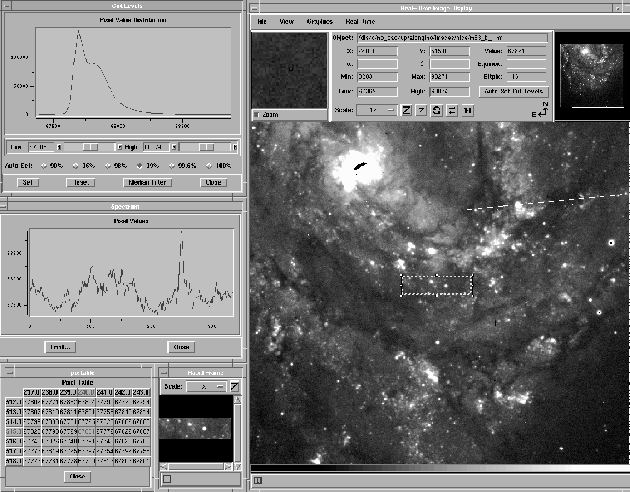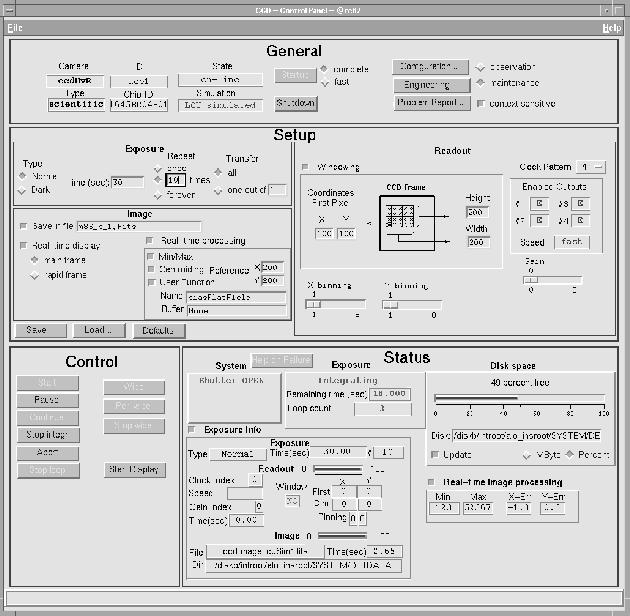
Figure: VLT CCD and Real-Time Display. Original PostScript figure (2.3MB).
Next: The Observatory Monitoring System: Analysis of Spacecraft Jitter
Previous: Calibration and Performance Control for the VLT Instrumentation
Up: Instrument-Specific Software
Table of Contents - Index - PS reprint - PDF reprint
Antonio Longinotti
European Southern Observatory, Garching bei München, D-85748 Germany,
E-mail: alongino@eso.org
The VLT Control System is a distributed system consisting of a set of UNIX Workstations, dedicated to high level operations, such as coordination of sub-system activities and interface to the users, and VME-based Local Control Units (LCU), dedicated to the control of sub-systems hardware. The operating system used on the LCUs is VxWorks. All computing units-Workstations and LCUs-are connected through LANs.
The CCD Software Package (Longinotti et al. 1995) is built on top of the VLT common software, which is a layer of services (drivers, libraries, utilities) used by all VLT applications (Raffi 1995). It has been designed as one package to control all CCD cameras, both scientific (SCCD) and technical (TCCD). In this way, costs for software maintenance are reduced and the interface to applications is standardized, in that instrumentation and telescope software interface to all cameras in one and the same way (§ 4). It became available as part of the VLT Software in October 1995, and four releases have been issued since then. It is currently used at the ESO New Technology Telescope for auto-guiding (two TCCDs), image analysis for active optics (two TCCDs), image quality assessment (two TCCDs), the EMMI instrument (two SCCDs and one TCCD for slit viewing), and the SUSI instrument (one SCCD). It is also used by the VLT FORS instrument (one SCCD), and in ESO labs for SCCD and TCCD new chip and camera tests and verification.
In addition to the two standard platforms (Workstation and LCU) described above, a third-called Array Control Electronics (ACE), and based on a transputer network and DSP-is used to control the CCD camera head.
The software running on each platform has the following characteristics:
The language used is C, with Tcl/Tk used for GUIs.
The language used is C.
The languages used are Occam (transputers) and C (DSP).

Figure: VLT CCD and Real-Time Display.
Original PostScript figure (2.3MB).
Compared to the previous generation of ESO CCD systems, in addition to the standard functionality (different readout modes and speeds provided, binning, windowing, execution and control of an exposure, possibly repeated n times, storage of data in FITS files, telemetry, and temperature control), it implements:

Figure: VLT CCD stand-alone control panel.
Original PostScript figure (2.3MB).
The interface to external software is well defined and consists of standard components within the VLT software:
The CCD Software is able to work as a simple stand-alone instrument through a control panel, built using the VLT panel editor, which is based on Tcl/Tk (see Figure 2). Among others, it allows the following actions:
I would like to thank here the people who contributed to the development of the VLT CCD software, in particular, C. Cumani and P. Duhoux.
For more information or questions, please contact A. Longinotti (e-mail to alongino@eso.org).
Information can also be retrieved through anonymous ftp.
Raffi, G. 1995, The Messenger, 81 , 5
Herlin, T., Brighton, A., & Biereichel, P. 1995, The Messenger, 81, 6
Longinotti, A., Cumani C., & Duhoux, P. 1995, The Messenger, 82, 7
Next: The Observatory Monitoring System: Analysis of Spacecraft Jitter
Previous: Calibration and Performance Control for the VLT Instrumentation
Up: Instrument-Specific Software
Table of Contents - Index - PS reprint - PDF reprint